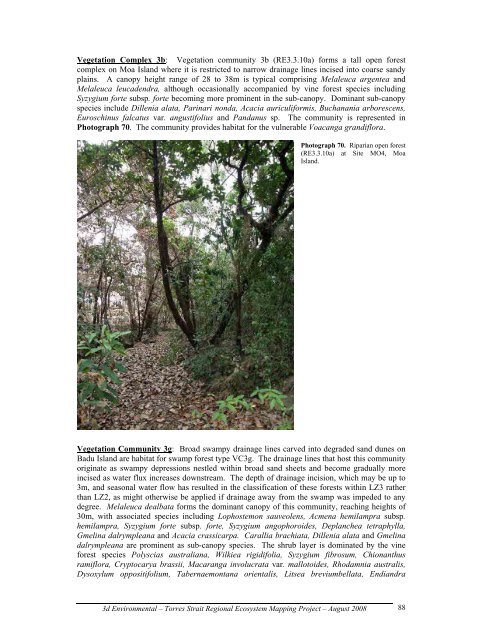Appendix 2 - Vegetation Communities and Regional Ecosystems
Appendix 2 - Vegetation Communities and Regional Ecosystems
Appendix 2 - Vegetation Communities and Regional Ecosystems
You also want an ePaper? Increase the reach of your titles
YUMPU automatically turns print PDFs into web optimized ePapers that Google loves.
<strong>Vegetation</strong> Complex 3b: <strong>Vegetation</strong> community 3b (RE3.3.10a) forms a tall open forest<br />
complex on Moa Isl<strong>and</strong> where it is restricted to narrow drainage lines incised into coarse s<strong>and</strong>y<br />
plains. A canopy height range of 28 to 38m is typical comprising Melaleuca argentea <strong>and</strong><br />
Melaleuca leucadendra, although occasionally accompanied by vine forest species including<br />
Syzygium forte subsp. forte becoming more prominent in the sub-canopy. Dominant sub-canopy<br />
species include Dillenia alata, Parinari nonda, Acacia auriculiformis, Buchanania arborescens,<br />
Euroschinus falcatus var. angustifolius <strong>and</strong> P<strong>and</strong>anus sp. The community is represented in<br />
Photograph 70. The community provides habitat for the vulnerable Voacanga gr<strong>and</strong>iflora.<br />
Photograph 70. Riparian open forest<br />
(RE3.3.10a) at Site MO4, Moa<br />
Isl<strong>and</strong>.<br />
<strong>Vegetation</strong> Community 3g: Broad swampy drainage lines carved into degraded s<strong>and</strong> dunes on<br />
Badu Isl<strong>and</strong> are habitat for swamp forest type VC3g. The drainage lines that host this community<br />
originate as swampy depressions nestled within broad s<strong>and</strong> sheets <strong>and</strong> become gradually more<br />
incised as water flux increases downstream. The depth of drainage incision, which may be up to<br />
3m, <strong>and</strong> seasonal water flow has resulted in the classification of these forests within LZ3 rather<br />
than LZ2, as might otherwise be applied if drainage away from the swamp was impeded to any<br />
degree. Melaleuca dealbata forms the dominant canopy of this community, reaching heights of<br />
30m, with associated species including Lophostemon sauveolens, Acmena hemilampra subsp.<br />
hemilampra, Syzygium forte subsp. forte, Syzygium angophoroides, Deplanchea tetraphylla,<br />
Gmelina dalrympleana <strong>and</strong> Acacia crassicarpa. Carallia brachiata, Dillenia alata <strong>and</strong> Gmelina<br />
dalrympleana are prominent as sub-canopy species. The shrub layer is dominated by the vine<br />
forest species Polyscias australiana, Wilkiea rigidifolia, Syzygium fibrosum, Chionanthus<br />
ramiflora, Cryptocarya brassii, Macaranga involucrata var. mallotoides, Rhodamnia australis,<br />
Dysoxylum oppositifolium, Tabernaemontana orientalis, Litsea breviumbellata, Endi<strong>and</strong>ra<br />
3d Environmental – Torres Strait <strong>Regional</strong> Ecosystem Mapping Project – August 2008<br />
88


